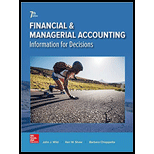
1.
To compute: Year 2013, 2014 and 2015 trend percents for net sales, cost of sales, operating income, other income(expense)net, provision for income taxes and net income of A Company by using 2013 as base year.
1.
Explanation of Solution
To compute trend percents, base amount is required firstly. Base amount is an amount which is predecided.
Formula to calculate trend percent is:
- Trend Percent (%)=Analysis Period AmountBase Period Amount×100
Trend percents are shown below:
| Particulars | 2015(%) | 2014(%) | 2013(%) |
| Net sales | 136.75 | 106.95 | 100 |
| Cost of sales | 131.41 | 105.30 | 100 |
| Operating income | 145.37 | 107.15 | 100 |
| Other income (expense) net | 111.16 | 84.78 | 100 |
| Provision for income taxes | 145.76 | 106.52 | 100 |
| Net income | 144.16 | 106.68 | 100 |
Working Notes:
Trend percents for Sales:
Trend percent 2015=$233,715$170,910×100 =136.75%
Trend percent 2014=$182,795$170,910×100 =106.95%
Trend percent 2013=$170,910$170,910×100 =100%
Trend percents for Cost of sales:
Trend percent 2015=$140,089$106,606×100 =131.41%
Trend percent 2014=$112,258$106,606×100 =105.30%
Trend percent 2013=$106,606$106,606×100 =100%
Trend percents for operating income:
Trend percent 2015=$71,230$48,999×100 =145.37%
Trend percent 2014=$52,503$48,999×100 =107.15%
Trend percent 2013=$48,999$48,999×100 =100%
Trend percents for other income (expense) net:
Trend percent 2015=$1,285$1,156×100 =111.16%
Trend percent 2014=$980$1,156×100 =84.78%
Trend percent 2013=$1,156$1,156×100 =100%
Trend percents for provision for income tax:
Trend percent 2015=$19,121$13,118×100 =145.76%
Trend percent 2014=$13,973$13,118×100 =106.52%
Trend percent 2013=$13,118$13,118×100 =100%
Trend percents for net income:
Trend percent 2015=$53,394$37,037×100 =144.16%
Trend percent 2014=$39,510$37,037×100 =106.68%
Trend percent 2013=$37,037$37,037×100 =100%
Thus, Except other income (expenses). All other items show increased percents in every year.
2.
To compute: Common size percent of (a) total current assets (b) property, plant and equipment, net and (c)
2.
Explanation of Solution
Formula to calculate common size percent is:
- Common Size Percent (%)=Analysis Year AmountBase Year Amount×100
Common size percents are shown below:
| Particulars | 2015(%) | 2014(%) |
| (a) Total current assets | 30.77 | 29.56 |
| (b) Property, plant and equipment, net | 7.74 | 8.9 |
| (c) Goodwill plus acquired intangible assets, net | 3.10 | 3.78 |
Working notes:
(a) Common size percents of total current assets:
- Common size percent 2015 =$89,378$290,479×100 =30.77%
- Common size percent 2014 =$68,531$231,839×100 =29.56%
(b) Common size percents of property, plant and equipment, net:
- Common size percent 2015 =$22,471$290,479×100 =7.74%
- Common size percent 2014 =$20,624$231,839×100 =8.9%
(c) Common size percents of goodwill plus acquired intangible assets, net:
- Common size percent 2015 =$9009$290,479×100 =3.10%
- Common size percent 2014 =$8758$231,839×100 =3.78%
3.
To explain: Changes across the year for the income statement trends computed in part 1 and the balance sheet percents computed in part 2.
3.
Explanation of Solution
- Trend percents of income statement items represent an increased trend. Such as net sales trend percent is 136.75 in the year 2015 and 106.95 in the 2014 same has been increases with 29.8 (136.75-106.95).
- Only other income is reduced in 2014, all other income statement trends show increased numbers.
- Common size percent of balance sheet items shows increase in the current assets of the company. For example total current assets of the company have been increased to 30.77% in 2015 year from 29.56% in 2014.
- Other assets marginaly reduced in 2015 as a percentage of total assets.
Thus, A Company works quite efficiently.
Want to see more full solutions like this?
Chapter 13 Solutions
GEN COMBO FINANCIAL AND MANAGERIAL ACCOUNTING; CONNECT ACCESS CARD
- Can you explain the process for solving this financial accounting problem using valid standards?arrow_forwardPlease help me solve this general accounting problem with the correct financial process.arrow_forwardCan you explain this general accounting question using accurate calculation methods?arrow_forward

 AccountingAccountingISBN:9781337272094Author:WARREN, Carl S., Reeve, James M., Duchac, Jonathan E.Publisher:Cengage Learning,
AccountingAccountingISBN:9781337272094Author:WARREN, Carl S., Reeve, James M., Duchac, Jonathan E.Publisher:Cengage Learning, Accounting Information SystemsAccountingISBN:9781337619202Author:Hall, James A.Publisher:Cengage Learning,
Accounting Information SystemsAccountingISBN:9781337619202Author:Hall, James A.Publisher:Cengage Learning, Horngren's Cost Accounting: A Managerial Emphasis...AccountingISBN:9780134475585Author:Srikant M. Datar, Madhav V. RajanPublisher:PEARSON
Horngren's Cost Accounting: A Managerial Emphasis...AccountingISBN:9780134475585Author:Srikant M. Datar, Madhav V. RajanPublisher:PEARSON Intermediate AccountingAccountingISBN:9781259722660Author:J. David Spiceland, Mark W. Nelson, Wayne M ThomasPublisher:McGraw-Hill Education
Intermediate AccountingAccountingISBN:9781259722660Author:J. David Spiceland, Mark W. Nelson, Wayne M ThomasPublisher:McGraw-Hill Education Financial and Managerial AccountingAccountingISBN:9781259726705Author:John J Wild, Ken W. Shaw, Barbara Chiappetta Fundamental Accounting PrinciplesPublisher:McGraw-Hill Education
Financial and Managerial AccountingAccountingISBN:9781259726705Author:John J Wild, Ken W. Shaw, Barbara Chiappetta Fundamental Accounting PrinciplesPublisher:McGraw-Hill Education





